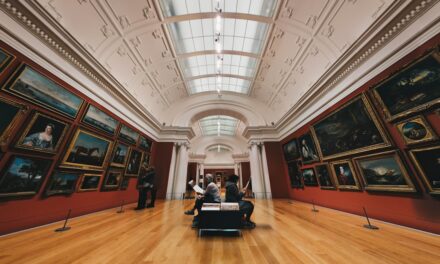The selection of a theme is a pivotal first step in curating a personal art exhibit. A well-defined theme not only provides a cohesive narrative for the artworks but also invites viewers to engage with the pieces on a deeper level. When contemplating a theme, consider your artistic journey, the messages you wish to convey, and the emotions you want to evoke.
Themes can range from the deeply personal, such as exploring identity or memory, to broader societal issues like climate change or cultural heritage. The key is to choose a theme that resonates with you and reflects your artistic voice, allowing your audience to connect with your work on multiple levels. Moreover, it is essential to ensure that your chosen theme is not only meaningful but also relevant to contemporary discussions within the art world.
Researching current trends and dialogues can provide inspiration and context for your exhibit. For instance, if you are drawn to themes of resilience and hope, consider how these concepts are being explored by other artists and how they can be interpreted through your unique lens. By grounding your theme in both personal significance and broader relevance, you create an opportunity for dialogue and reflection among your audience, enriching their experience of your work.
Summary
- When selecting a theme for your personal art exhibit, consider a concept that resonates with you and allows for a cohesive collection of artworks.
- When choosing artworks for display, aim for a balance of different styles, mediums, and sizes to create visual interest and variety.
- Creating an engaging and cohesive setup involves thoughtful placement of artworks, consideration of lighting and flow, and the use of display tools such as pedestals and frames.
- Designing the exhibition space requires attention to details such as wall colour, flooring, and signage to enhance the overall aesthetic and atmosphere of the exhibit.
- Marketing and promoting your exhibit is crucial for attracting an audience, and can be done through social media, press releases, and collaborations with local galleries or art organisations.
Choosing Artworks for Display
Once you have established a theme, the next step is selecting the artworks that will best represent it. This process involves a careful curation of pieces that not only align with your chosen theme but also showcase the breadth of your artistic practice. Consider including a variety of mediums—such as painting, sculpture, photography, or mixed media—to create visual interest and engage different senses.
Each artwork should contribute to the overall narrative of the exhibit, allowing viewers to explore the theme from multiple perspectives. In addition to thematic relevance, it is crucial to consider the emotional impact of each piece. Reflect on how each artwork makes you feel and how it might resonate with your audience.
You may wish to include pieces that evoke strong emotions or provoke thought, as these can lead to meaningful conversations during the exhibit. Furthermore, think about the arrangement of the artworks; the flow from one piece to another can significantly influence how viewers experience the exhibit as a whole. A well-curated selection will not only highlight your artistic evolution but also invite viewers to embark on a journey through your creative vision.
Creating an Engaging and Cohesive Setup
An engaging setup is vital for drawing viewers into your exhibit and encouraging them to interact with the artworks. Consider how the arrangement of pieces can create a narrative arc that guides visitors through the space. This might involve grouping works by medium, colour palette, or thematic elements, allowing for a natural progression that enhances understanding and appreciation.
Additionally, think about incorporating text panels or labels that provide context for each piece, offering insights into your creative process and the themes explored. Lighting plays a crucial role in creating an inviting atmosphere and highlighting the details of each artwork. Experiment with different lighting techniques to find the right balance that accentuates the textures and colours of your pieces without overwhelming them.
Ambient lighting can create a warm and welcoming environment, while spotlights can draw attention to specific works. Ultimately, the goal is to create a cohesive setup that not only showcases your art but also fosters an immersive experience for viewers, encouraging them to linger and reflect on what they see.
Designing the Exhibition Space
The design of the exhibition space is an integral aspect of presenting your art effectively. Whether you are utilising a gallery, community centre, or alternative venue, it is essential to consider how the physical environment interacts with your artworks. Begin by assessing the layout of the space; think about how you can utilise walls, floors, and even ceilings to enhance visibility and accessibility.
Creating distinct zones within the space can help delineate different themes or sections of your exhibit, guiding visitors through your artistic narrative. In addition to layout considerations, pay attention to the overall aesthetic of the exhibition space. The colour scheme of the walls, flooring materials, and even furniture can influence how your artworks are perceived.
Neutral tones often work best as they allow the art to take centre stage without distraction. However, if your theme calls for it, bold colours or unique textures can add an exciting dimension to the experience. Remember that every element within the space contributes to the overall atmosphere; thus, thoughtful design choices will enhance viewer engagement and appreciation for your work.
Marketing and Promoting Your Exhibit
Effective marketing is essential for ensuring that your personal art exhibit reaches its intended audience. Begin by identifying your target demographic—who do you want to attract? This could include art enthusiasts, local community members, or even specific groups interested in your chosen theme.
Once you have defined your audience, develop a marketing strategy that utilises various channels such as social media, email newsletters, and local press releases. Engaging visuals of your artworks can be particularly effective in capturing attention online. In addition to digital marketing efforts, consider hosting pre-exhibit events or workshops that align with your theme.
These activities can generate buzz and foster community engagement while providing opportunities for potential visitors to connect with you and your work before the exhibit opens.
Ultimately, a well-rounded marketing approach will help ensure that your exhibit garners interest and attracts a diverse audience.
Hosting an Opening Reception
The opening reception is often seen as the highlight of any art exhibit; it serves as an opportunity for you to connect with viewers and share insights about your work in person. Planning this event requires careful consideration of logistics and atmosphere. Begin by determining whether you will offer refreshments or entertainment—live music or spoken word performances can create an inviting ambiance that encourages mingling and conversation among guests.
During the reception, take time to engage with attendees individually or in small groups. Sharing stories behind specific pieces or discussing your creative process can foster deeper connections with viewers and enhance their understanding of your work. Additionally, consider providing printed materials such as brochures or catalogues that outline your artistic journey and offer further context for each piece on display.
This not only enriches their experience but also serves as a tangible takeaway that keeps your art in their minds long after they leave.
Managing the Logistics of the Exhibit
Managing logistics is a crucial aspect of ensuring that your personal art exhibit runs smoothly from start to finish. Begin by creating a detailed timeline that outlines all necessary tasks leading up to the opening day—this includes everything from securing permits and insurance to arranging transportation for artworks and setting up the exhibition space. Staying organised will help alleviate stress as you approach the event date.
Additionally, consider how you will handle sales during the exhibit if applicable. Establish clear pricing for each piece and determine whether you will accept commissions or offer prints alongside original works. Having a reliable payment system in place will streamline transactions and enhance the overall experience for buyers.
Furthermore, ensure that you have adequate staffing during the exhibit; having knowledgeable individuals available to answer questions about your work can significantly enhance visitor engagement.
Reflecting on the Success of Your Personal Art Exhibit
After the closing of your personal art exhibit, take time to reflect on its success and gather feedback from attendees.
Consider conducting surveys or informal interviews with visitors to gain insights into their experiences; this feedback can inform your future artistic endeavours and exhibition planning.
Moreover, documenting the exhibit through photographs or video can serve as a useful resource for promoting future events or applying for grants and residencies. Reflecting on both successes and challenges will not only help you grow as an artist but also deepen your understanding of how best to connect with audiences in future exhibitions. Ultimately, each exhibit is a stepping stone in your artistic journey—embracing this process will enrich both your practice and your relationship with viewers in meaningful ways.
When curating a personal art exhibit, it is important to consider the theme, setup, and execution to ensure a cohesive and impactful display. One related article that provides insight into the world of art is An Introduction to the Fundacion Joan Miro, Barcelona, Spain. This article explores the renowned foundation dedicated to the work of the iconic artist, offering valuable information on the art world and its significance. By delving into such resources, artists can gain inspiration and knowledge to enhance their own creative endeavours.



